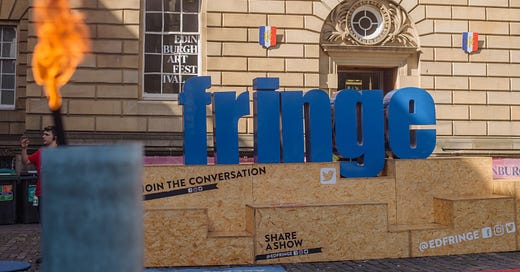IS THE EDINBURGH FRINGE WORTH IT?
For artists and producers alike, the famous fest is more expensive than ever. Here's what keeps them coming back.
It comes up every year at around this time: People are worried about the Edinburgh Festival Fringe. It’s not getting the government support it needs to survive. Costs—particularly accommodation expenses—have become exorbitantly high. People in the theater industry whisper that they’re hearing of more and more decisionmakers deciding to skip the Fringe because the scrappy, bootstrapped creativity that is the festival’s lifeblood has been priced out completely.
Jaques is your weekly guide to the global theater industry. New to Jaques? Check out this handy explainer, and if you’re looking for the latest edition of ABROAD/WAY BULLETPOINTS, my regular round-up of international theater headlines, it’s right this way.
Some facets of the business will tell you that at this point, Edinburgh is no longer the place for a scout to discover an unheralded talent or a grassroots, small-scale work. These days, the majority of shows that can afford an EFF run arrive already backed by producers who are strategizing an (increasingly costly) festival engagement as part of a broader commercial life.
Judging by the conversations I had for this story, both on and off the record: That’s not wrong. Everyone I talked to seemed to agree—either implicitly, given how these producers and artists think about the utility of the contemporary Fringe, or in explicitly expressed concerns.
And it’s certainly true that fewer shows are playing the Fringe these days. A recent article in The Scotsman notes that this year’s list of 3,300 productions comes in well under the high of 2019, when there were 3,841 shows on offer. Meanwhile, the number of Fringe venues has dropped by almost a fifth, from 323 in 2019 to 262 this year.
And yet: 3,300 is a lot of shows. Clearly there are plenty of artists and producers out there who are managing to raise the requisite funds, and feel the high cost of entry is still worth it. Here’s why they think so.
In this SPOTLIGHT STORY, I’ll highlight:
just how high expenses have risen,
the potential benefits that can make the risk worth it,
the realistic expectations to have,
the strategies of the hitmakers,
a complete budget breakdown of one of this year’s shows, and
first-hand insights from some of this year’s participants, ranging from a Fringe newbie like actor Joanna Parson to repeaters like producer Francesca Moody (Fleabag, Baby Reindeer).
Coming up: The state of the Fringe, according to artists and producers in the 2024 lineup.
YOUR SHOW IS PROBABLY NOT THE NEXT FLEABAG
“When you take a show to the Fringe, it’s important to keep your expectations low,” says the producer Francesca Moody—and it might be surprising to hear it from her, because one of her shows has become the contemporary poster child for stars-in-your-eyes, best-case Fringe success.
Keep reading with a 7-day free trial
Subscribe to Jaques to keep reading this post and get 7 days of free access to the full post archives.




